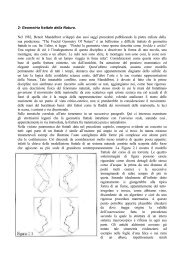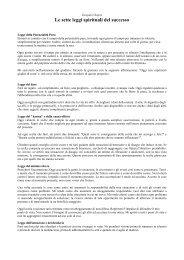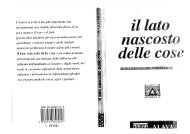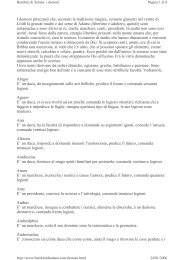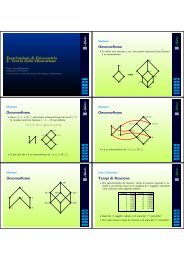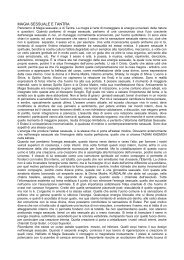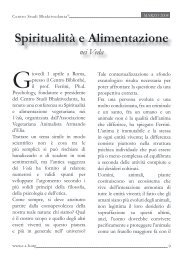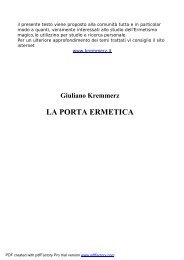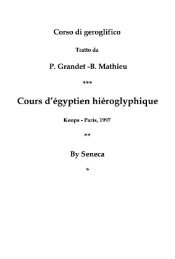96 ~ TALIBANmovement itself and they set out to conquer the rest of the country toprove it.The initial hopes generated by the Taliban were a direct result of thedegeneration of the former Mujaheddin leadership. During the jihad, theMujaheddin leadership based in Peshawar was highly factionalized andpersonalised. The parties were held together by charismatic leaders andwarlords rather than an organisation. As the war progressed these leadersbecame more and more dependent on Western supplied funds and armsto keep their field commanders and guerrilla fighters loyal. They spentmuch of their time literally buying support inside Afghanistan, whilebickering with each other in Peshawar.Pakistan only helped fuel this process of disunity. General Zia ul Haqhad commanded Pakistani troops in Jordan in 1970 and had helped KingHussein crush the Palestinians. He had seen at first hand the threat thata united guerrilla movement posed to the state where it had been givensanctuary. By maintaining a disunited movement with no single leader,Zia was able to keep the Mujaheddin leaders obligated to Pakistan andWestern largesse. But when Islamabad desperately needed a coherentMujaheddin leadership to present a political alternative to the communistregime in Kabul in 1989 as Soviet troops withdrew, and again in 1992 asthe NajibuUah regime collapsed, the disunity amongst the Peshawar-basedMujaheddin leaders was too far gone to mend - even with significantbribes. This disunity was to have a profound effect on Afghanistan's futureinability to achieve a consensus government.The second element in the anti-Soviet resistance leadership were thefield commanders, who became increasingly frustrated by the disunity andcorruption of the Peshawar leaders and the ease with which they wereheld hostage over funds and weapons supplies. The very nature and hardshipof the war demanded that they cooperate with each other, despitethe feuding of their party chiefs in Peshawar.There was a passionate desire for greater structural unity amongst thefield commanders. Ismael Khan organized the first meeting of field commandersin Ghor province in July 1987, which was attended by some1,200 commanders from across Afghanistan. They adopted 20 resolutionsof which the most important was the demand that they, rather than thePeshawar leaders, dictate the political movement. 'The right of determiningthe future destiny of Afghanistan lies with the heirs of the martyrsand with the Muslims of the trenches, who are struggling in bloody frontsand are ready to be martyred. Nobody else is allowed to make decisionsdetermining the fate of the nation.' 1Some 300 commanders met again in Paktia province in July 1990 andin Badakhshan in October. However, ethnicity, personal rivalries and theurge to be the first into Kabul broke down their consensus as the Mujahed'THE TALIBAN'S POLITICAL AND MILITARY ORGANISATION 97din competed to seize the capital in 1992. The battle for Kabul broughtthe divisions between north and south and Pashtuns and non-Pashtunsinto the open. Ahmad Shah Masud's inability to compromise with Pashtuncommanders opposed to Hikmetyar, even as Masud seized Kabul in1992, badly dented his political reputation. He was never to regain thetrust of Pashtuns, until after the Taliban had conquered the north in1998.A third level of leadership within the resistance were the scholars,intellectuals, businessmen and technocrats who had escaped from Kabulto Peshawar. Many remained independent advocating unity amongst allthe resistance forces. But this group of educated Afghans was never givena serious political role by the Peshawar parties nor by Pakistan. As aconsequence many left Peshawar for foreign countries, adding to the diasporaof Afghan professionals. They became marginal in influencing politicalevents at home and when they were needed after 1992 to help rebuildthe country, they were not available- 2 The Pashtun ulema and mairassateachers were scattered throughout the resistance movement, some asparty leaders in Peshawar, others as field commanders, but they formed nounited, powerful presence within the resistance and even their individualinfluence had waned considerably by 1992. The ulema were ripe to betaken over by a Taliban style movement.When the Taliban emerged in 1994 only the old, bickering resistanceleadership was left and President Burhanuddin Rabbani had failed to unitethem. In the Pashtun areas there was a total vacuum of leadership aswarlordism gripped the south. The Taliban rightly considered the formerMujaheddin leaders as redundant and corrupt. Although the Talibanrevered some leaders from the ukma who were their earlier mentors, theygave them no political role in their movement. Nor did the Taliban haveany liking for the independent-minded field commanders, whom theyblamed for the debacle of the Pashtuns after 1992. Important field commanderswho surrendered to the Taliban were never elevated within theTaliban military structure. The Taliban also completely rejected Afghanintellectuals and technocrats, as they considered them the spawn of aWestern or Soviet-style educational system which they detested.The Taliban's emergence thus coincided with a fortunate historicaljuxtaposition, where the disintegration of the communist power structurewas complete, the Mujaheddin leaders were discredited and the traditionaltribal leadership had been eliminated. It was relatively easy for theTaliban to sweep away what little of the old Pashtun leadership was left.Thereafter, from within the Pashtuns, the Taliban faced no possible politicalchallenges to their rule. They now had the opportunity to build atribal-democratic, grass-roots organisation. Imbued with the legitim-
98 TALIBANizing factor of Islam, it could have responded to the population's needs,but the Taliban proved incapable and unwilling to do this.At the same time, they refused to evolve a mechanism by which theycould include the representatives of the non-Pashtun ethnic groups. Theirsupreme position in the Pashtun areas could not be duplicated in thenorth unless they had the flexibility to unite the complex mosaic of theAfghan nation under a new style of collective leadership. Instead, whatthe Taliban ultimately created was a secret society run mainly by Kandaharisand as mysterious, secretive and dictatorial in its ways as the KhmerRouge of Cambodia or Saddam Hussein's Iraq.The Taliban's apex decision-making body was the Supreme Shurawhich continued to be based in Kandahar, a city which Mullah Omar hasleft only once (to visit Kabul in 1996) and which he turned into the new;power centre for Afghanistan. The Shura was dominated by Omar's originalfriends and colleagues, mainly Durrani Pashtuns, who came to becalled the 'Kandaharis', even though they hailed from the three provincesofKandahar, Helmand and Urozgan. The original Shura was made up often members, (see Appendix 2) but military commanders, tribal eldersand ulema took part in Shura meetings so that it remained loose andamorphous with as many as 50 people often taking part.Of the ten original Shura members, six were Durrani Pashtuns and onlyone, Maulvi Sayed Ghiasuddin, was a Tajik from Badakhshan (he hac|lived for a long time within the Pashtun belt). This was sufficient as longas the Taliban were advancing in the Pashtun belt but after the captureof Herat and Kabul, the Shura became totally unrepresentative. The KandaharShura never broadened its base sufficiently to include Ghilzai Pasl*tuns or non-Pashtuns. It has remained narrowly based and narrowly^focused, unable to represent the interests of the entire nation.Two other Shuras report to the Kandahar Shura. The first is the cabin*of acting ministers in Kabul or the Kabul Shura. The second is the militarycouncil or military Shura. Out of 17 members in the Kabul Shura to!1998, at least eight were Durranis while three are Ghilzais and only twowere non-Pashtuns (see Appendix 2). The Kabul Shura deals with theday-to-day problems of the government, the city and the Kabul militaryfront, but important decisions are conveyed to the Kandahar Shura wheredecisions are actually taken. Even minor decisions taken by the KabulShura and its chief Mullah Mohammed Rabbani, such as permission forjournalists to travel or new UN aid projcts, have been frequently revokedby the Kandahar Shura. It soon became impossible for the Kabul Shura,which acted as the government of Afghanistan, to take any decision withoutlengthy consultations with Kandahar, delaying decisions intermin*;ably.In Kabul and Herat and later in Mazar - none of which have a PashTHE TALIBAN'S POLITICAL AND MILITARY ORGANISATION ~ 99majority - the Taliban's representatives such as the governor, mayor,police chiefs and other senior administrators are invariably KandahariPashtuns who either do not speak Dari, the lingua franca of these citiesor speak it poorly. There is no prominent local citizen in any of theselocal Shuras. The only flexibility the Taliban have demonstrated is intheir appointments of governors to the provinces. Of 11 governors in1998, only four were known to be Kandaharis. 3 In the past the governorsand senior local officials were usually drawn from the local elite, reflectingthe local ethnic make-up of the population. The Taliban broke with thistradition and appointed outsiders.However, the political powers of the Taliban governors have been considerablyreduced. The paucity of funds at their disposal, their inability tocarry out serious economic development or rehabilitate refugees returningfrom Pakistan and Iran gave governors even less of a political, economicor social role. Mullah Omar has also kept the governors under controland not allowed them to build up a local power base. He has constantlyshifted them around and sent them back to the battle front as commanders.After the Mazar defeat in 1997 there was growing criticism from GhilzaiPashtun commanders that they were not being consulted on military andpolitical issues, despite the fact that they now provided the bulk of themilitary manpower. In Mazar the Taliban lost some 3,000 of their besttroops, 3,600 were taken prisoner and ten leaders were killed or captured.Thus the Taliban were forced to draw upon new recruits from the Ghilzaitribes of eastern Afghanistan but the Taliban were not prepared to yieldthem political power or include them in the Kandahar Shura. Increasinglythe Ghilzais were not prepared to accept being used as cannon fodder bythe Taliban and resisted recruitment.The military structure of the Taliban is shrouded in even greatersecrecy. The head of the armed forces is Mullah Omar although there isno actual definition of his position or his role. Under Omar there is achief of general staff and then chiefs of staff for the army and air force.There are at least four army divisions and an armoured division based inKabul. However, there is no clear military structure with a hierarchy ofofficers and commanders, while unit commanders are constantly beingshifted around. For example, the Taliban's Kunduz expeditionary force,which was the only military group in the north after the 1997 Mazardebacle, saw at least three changes of command in three months, whilemore than half the troops were withdrawn and flown to the Herat frontand replaced by less experienced Pakistani and Afghan fighters. The militaryShura is a loose body which plans strategy and can implement tacticaldecisions, but appears to have no strategic decision-making powers. Milit-
- Page 1 and 2:
YALE NOTA BENE"The broader storyher
- Page 3 and 4:
TalibanMilitant Islam,Oil and Funda
- Page 5 and 6: Vi ~ CONTENTSChapter 8A Vanished Ge
- Page 7 and 8: AFGHANISTAN•^ UZBEKISTAN J TAJIKI
- Page 9 and 10: 2 ~ TALIBANaccounts for some 40 per
- Page 11 and 12: "6 ~ TALIBANgas riches of landlocke
- Page 13 and 14: 10 ~ TALIBANgious mix that was to m
- Page 15 and 16: Part 1History of theTaliban Movemen
- Page 17 and 18: 18 ~ ISLAM OIL AND THE NEW GREAT GA
- Page 19 and 20: 22 ~ ISLAM OIL AND THE NEW GREAT GA
- Page 21 and 22: 26 ~ ISLAM OIL AND THE NEW GREAT GA
- Page 23 and 24: 30 ~ ISLAM OIL AND THE NEW GREAT GA
- Page 25 and 26: 34 TALIBANKabul- Hikmetyar had alli
- Page 27 and 28: 38 ~ TALIBANrHERAT 1995: GOD'S INVI
- Page 29 and 30: 42 ~ TALIBANdo manage to take Kabul
- Page 31 and 32: J46 ~ TALIBANgreater weight to UN e
- Page 33 and 34: 50 ~ TALIBANas they hung from steel
- Page 35 and 36: 54 ~ TALIBANthey would help rearm t
- Page 37 and 38: 58 TALIBANGul Mohammed Pahlawan, Gh
- Page 39 and 40: 62 TALIBAN2,500 Taliban, who had re
- Page 41 and 42: 66 TALIBANshould throw all aid agen
- Page 43 and 44: 70 ~ TALIBANyears of battle and hel
- Page 45 and 46: 74 ~ TALIBANThousands of Hazaras we
- Page 47 and 48: 78 TALIBANhas become a plague,' sai
- Page 49 and 50: NEW STYLE FUNDAMENTALISM OF THE TAL
- Page 51 and 52: 86 TALIBANsity students - Hikmetyar
- Page 53 and 54: 90 TALIBANSharia was heavily influe
- Page 55: 94 TALIBANinflamed the debate in th
- Page 59 and 60: 102 TALIBANadministrations made the
- Page 61 and 62: 106 ~ TAUBANfrom working, but it no
- Page 63 and 64: TALIBANUniversity, she held down a
- Page 65 and 66: 114 TALIBAN A VANISHED GENDER 115Ta
- Page 67 and 68: 118 TALIBANUS$1,300 - a small fortu
- Page 69 and 70: 122 TALIBANper cent of the total Pa
- Page 71 and 72: 126 TALIBANequipment, no electricit
- Page 73 and 74: 130 ~ TALIBANfight with the Mujahed
- Page 75 and 76: 134TALIBANAugust 1996 noted that Bi
- Page 77 and 78: 138 ~ TALIBANwho were using the Kho
- Page 79 and 80: 11DICTATORS AND OILBARONS: THE TALI
- Page 81 and 82: 146 TALIBAN DICTATORS AND OIL BARON
- Page 83 and 84: 150 — TALIBANgrowth of beards and
- Page 85 and 86: 154TALIBAN1998 when international o
- Page 87 and 88: 158 ~ TALIBANaround Afghanistan? Af
- Page 89 and 90: 162 TALIBAN ROMANCING THE TALIBAN 1
- Page 91 and 92: 166 TALIBAN ROMANCING THE TALIBAN 1
- Page 93 and 94: ROMANCING THE TALIBAN 2: 1997-99 17
- Page 95 and 96: 174 — TALIBANnon-Russian pipeline
- Page 97 and 98: 178 — TALIBANROMANCING THE TALIBA
- Page 99 and 100: 182 ~ TALIBANApril 1999. 'The US ha
- Page 101 and 102: 186 ~ TALIBANters or the transport
- Page 103 and 104: 190 ~ TALIBANThis Wild West of free
- Page 105 and 106: 194 ~ TALIBANgovernance. Pakistani
- Page 107 and 108:
198 TALIBAN SHIA VERSUS SUNNI: IRAN
- Page 109 and 110:
202 TALIBAN SHIA VERSUS SUNNI: IRAN
- Page 111 and 112:
206 — TALIBANin Afghanistan - to
- Page 113 and 114:
210 — TALIBANand antagonism. The
- Page 115 and 116:
214 ~ TALIBANdrawn since 1996 - a P
- Page 117 and 118:
218 ~ TALIBANated and severely puni
- Page 119 and 120:
Origins of Members of the Taliban M
- Page 121 and 122:
APPENDIX 3 ~ 227Appendix 3A CHRONOL
- Page 123 and 124:
230 ~ TALIBANgraves near Shebarghan
- Page 125 and 126:
234 ~ TALIBAN8 June. US FBI places
- Page 127 and 128:
238 ~ TALIBAN1995 January16 MarchAp
- Page 129 and 130:
242 ~ TALIBANJune21 August10 Septem
- Page 131 and 132:
246 ~ TALIBANDupree, Nancy Hatch, A
- Page 133 and 134:
250 ~ NOTESChapter 31 Interview wit
- Page 135 and 136:
254 ~ NOTESmuddin, Religious Police
- Page 137 and 138:
258 NOTES13. The Japanese company M
- Page 139 and 140:
262 ~ NOTES28. Waxman, Sharon, 'A c
- Page 141 and 142:
Abbas, Mulla Mohammed 22,61,100Abda
- Page 143 and 144:
INDEX - 270Hazaras (continued)burea
- Page 145 and 146:
INDEX ~ 274nF»r\/FaliViar» milita
- Page 147:
INDEX ~ 278Talibans (continued)Sunn




